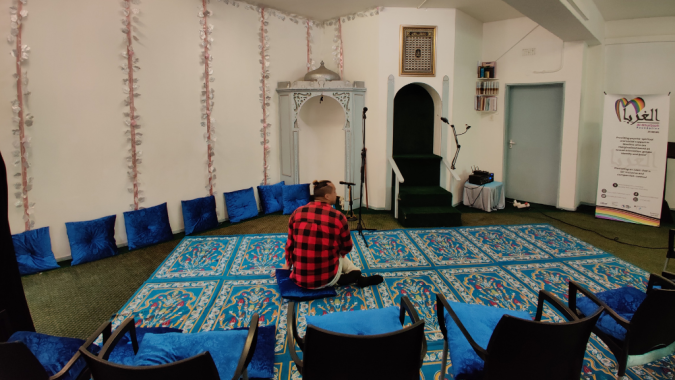Seeking Peace in Queer Mosques

The recent murder of Muhsin Hendricks, the world’s “first openly gay imam”, highlights the fragile balance between safety and vulnerability for queer Muslims. Their struggle raises urgent questions about peace, faith, and the right to live without fear.
South Africa is often celebrated as a global pioneer in LGBTQ+ rights: it was the first African country to legalize same-sex marriage in 2006, and its constitution explicitly prohibits discrimination based on sexual orientation. On paper, some would say that the queer people have stronger rights there than in many Western states.
In reality, the situation is far more complex. Scholars have shown that legal progress does not automatically translate into social acceptance, especially in contexts where religion and cultural traditions carry heavy weight (Osman 2023). Violence, discrimination, and rejection within religious communities remain everyday experiences for many queer Muslims. The gap between law and lived reality generates constant insecurity: can one enter a mosque openly, reveal one’s identity within family circles, or love visibly in public spaces?
The Legacy of Muhsin Hendricks
I was privileged to meet and work with Muhsin Hendricks during my three-month fieldwork in Cape Town in 2024. Even when he was internationally recognized as the world’s first openly gay imam, Muhsin personally preferred to be “just a queer Muslim”. In Cape Town, he founded organisations and a mosque that created a safe space for all queer Muslims and other marginalized groups. His work connected Islamic liberation traditions with queer activism, showing that faith and sexuality did not need to be in conflict, but could instead reinforce one another.
Hendricks’ life can be read through the lens of queer jihad – a liberatory struggle where faith and identity intertwine in acts of resistance and hope (Osman 2023). In this articulation, queer Muslims reimagine Islamic traditions by turning marginality into a site of theology, dignity, and communal practice. I got to experience this personally with Muhsin’s wishes to make the Islamic jurisprudence, Fiqh, more inclusive to the sexual and gender minorities inside Islam.
His murder in February 2025 ended his life, but not his legacy. As those close to him emphasized afterwards, every queer Muslim who now dares to pray without shame carries forward his vision. He demonstrated that safety is not only created by constitutional law, but also by communities building inclusive sacred spaces for us all.
Queer Muslims in Europe and Finland
South Africa’s situation is not unique. In Europe, queer Muslims similarly live between safety and vulnerability. Mosques can function as protective spaces against Islamophobia, but they are not always safe for queer individuals (Golriz 2021). Many rely on a “don’t ask, don’t tell” strategy: as long as their identity remains hidden, they are tolerated.
German scholar Fatima El-Tayeb describes queer Muslims in Europe as “people who cannot properly be gay, nor properly be Muslim” (2012). This double marginalization makes them invisible both in mainstream LGBTQ+ communities and in their own religious communities at the same time.
In Finland, where public attitudes toward Islam are statistically particularly negative (Pew 2018), the situation is complex. For queer Muslims, marginalization works in two directions: Islamophobia on one side, homophobia and transphobia on the other. Safety is often found only in private networks, online forums, or temporary community initiatives, rarely in the institutions that should provide belonging.
Religion, Identity, and the Conditions of Acceptance
It is often assumed that queer Muslims face an insurmountable conflict between religion, gender and sexuality only. Yet research indicates that religion alone does not explain rejection or acceptance. Acceptance also depends on broader social and cultural factors: family expectations, community norms, and political climate – not merely theological dogma (Golriz 2021).
Asifa Siraj’s research on British Muslim lesbians shows that many do not want to abandon their faith, but instead reconstruct it. By reclaiming Islam on their own terms, they challenge the condemnation of homosexuality and build an alternative, queer-friendly religious identity (Siraj 2016). For these women, Islam remains central to life and morality, even as they resist exclusionary interpretations.
Building Peace Through Safety
Globalisti-magazine’s theme for this issue is war, peace, and gender. For queer Muslims, peace is not simply the absence of war, but the right to live without fear of discrimination, violence, or spiritual exclusion. Hendricks’ mosque in Cape Town was a concrete embodiment of such peace: a place where faith and identity could coexist.
What then should we do in Finland? First, we can recognize queer Muslims’ existence and the specific challenges they face. This means emphasizing spaces where everyone can be themselves. Second, we must challenge both Islamophobia and discrimination of sexual and gender minorities simultaneously – neither can have a place in a society committed to peace.
The struggle for safety among queer Muslims continues in South Africa and worldwide. Every step toward safer spaces is also a step toward peace.
References:
- El-Tayeb, F. (2012). ‘“Gays who cannot properly be gay”: Queer Muslims in the neoliberal European public sphere’. European Journal of Women’s Studies, 17(2), 117–133. https://doi.org/10.1177/1350506811426388
- Golriz, G. (2021). ‘Does Religion Prevent LGBTQ Acceptance? A Case Study with Queer and Trans Muslims in Toronto, Canada’. Journal of Homosexuality, 68(14), 2451–2475. https://doi.org/10.1080/00918369.2020.1809888
- Osman, M. (2023). ‘Queering Jihad in South Africa: Islam, Queerness, and Liberative Praxis’. Religions, 14(9), 1081. https://doi.org/10.3390/rel14091081
- Siraj, A. (2016). ‘British Muslim lesbians: reclaiming Islam and reconfiguring religious identity’. Contemporary Islam, 10(2), 185–200. https://doi.org/10.1007/s11562-015-0348-9
- Pew Research Center (2018). Being Christian in Western Europe. Pew Research Center
The article is published in Globalisti 1/2026
